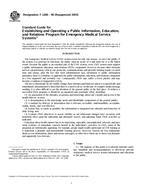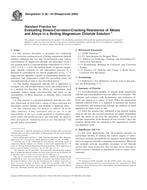1.1 This practice covers procedure for thick wall, split barrel drive sampling of soil to obtain representative samples of soil for classification and laboratory testing. The sampler is considered to be a thick wall sampler with sharpened cutting shoe and ball check vent. The middle barrel section is often of split barrel design, but a solid barrel can be used and both may contain ring liners. The sampler is often driven, but can also be pushed in softer deposits. Penetration resistance data may be recorded. This standard uses procedures similar to Test Method D1586 on Penetration Resistance and Split Barrel Sampling of Soils. However, in this practice, differing hammer weights, drop heights, and different size samplers are used, so the data must not be reported as conforming to Test Method D1586 and cannot be used to determine Normalized penetration resistance data for sands in accordance with Practice D6066.
1.2 This practice involves use of rotary drilling equipment (Guide D5783, Practice D6151). Other drilling and sampling procedures (Guide D6286, Guide D6169) are available and may be more appropriate. Considerations for hand driving or shallow sampling without boreholes are not addressed. Subsurface investigations should be recorded in accordance with practice Guide D5434. Soil samples should be classified in accordance with Practice D2488.
1.3 This practice may or may not provide a sample suitable for advanced laboratory tests such as shear or consolidation testing. It is up to the user to determine if the sample quality is suitable for advanced laboratory testing for engineering properties. Driven samples can be more easily disturbed than pushed samples such as the thin wall tube in accordance with Practice D1587. However, thin wall tubes cannot be used in harder soils. In cases where it has been established that the quality of the thick wall driven sample is adequate, this practice may provide shear and consolidation specimens that can be used directly in the test apparatus without prior trimming. Some types of soils may gain or lose significant shear strength or compressibility, or both, as a result of sampling. In cases like these, suitable comparison tests should be made to evaluate the effect of sample disturbance on shear strength and compressibility.
1.4 This guide does not purport to comprehensively address all of the methods and the issues associated with soil sampling. Users should seek qualified professionals for the decisions as to the proper equipment and methods that would be most successful for their site investigation. Other methods may be available for monitoring soil sampling and qualified professionals should have flexibility to exercise judgement as to possible alternatives not covered in this guide. The practice is current at the time of issue, but new alternative and innovative methods may become available prior to revisions, therefore, users should consult with manufacturers or producers prior to specifying program requirements.
1.5 This practice offers an organized collection of information or a series of options and does not recommend a specific course of action. This document cannot replace education or experience and should be used in conjunction with professional judgement. Not all aspects of this practice may be applicable in all circumstances. This ASTM standard is not intended to represent or replace the standard of care by which the adequacy of a given professional service must be judged, nor should this document be applied without consideration of a project’s many unique aspects. The word “Standard” in the title of this document means only that the document has been approved through the ASTM consensus process.
1.6 This standard does not purport to address all of the safety concerns, if any, associated with its use. It is the responsibility of the user of this standard to establish appropriate safety and health practices. The user must comply with prevalent regulatory codes, such as OSHA (Occupational Health and Safety Administration) guidelines while using this practice. For good safety practice, consult applicable OSHA regulations and other safety guides on drilling.
Product Details
- Published:
- 01/10/2001
- Number of Pages:
- 5
- File Size:
- 1 file , 67 KB
- Redline File Size:
- 2 files , 140 KB


